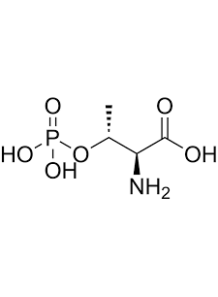O-Phospho-L-threonine
provides clear biomaterial-level health benefits—chiefly, accelerating bone bonding and guiding physiologic mineralisation—when it is grafted onto medical implants or embedded in engineered matrices
provides clear biomaterial-level health benefits—chiefly, accelerating bone bonding and guiding physiologic mineralisation—when it is grafted onto medical implants or embedded in engineered matrices
Key health-relevant findings reported for O-Phospho-L-threonine (p-Thr)
| Proposed benefit | Study model & main finding | Take-away for human health |
|---|---|---|
| Faster bone–implant integration | Rabbit femur model – titanium screws whose surface was covalently coated with p-Thr showed significantly higher initial osteoblast attachment (↑22 %), removal-torque, and bone-implant-contact ratios than un-coated screws.pubmed.ncbi.nlm.nih.gov | p-Thr can be used as a bio-active interface on dental / orthopaedic hardware to shorten healing time and improve long-term stability. |
| Surface chemistry for bone regeneration | In vitro, pretreating pure-titanium discs with p-Thr created a phosphate-rich layer that increased wettability and promoted calcium-phosphate precipitation, a first step toward hydroxyapatite formation.pubmed.ncbi.nlm.nih.gov | Shows why p-Thr is being explored as a simple, low-temperature method for functionalising titanium prior to implantation. |
| Guided biomineralisation of hard tissues | Synthetic polypeptides that incorporate p-Thr residues changed CaCO₃ or CaCO₃/PO₄ crystal habits from ordinary rhombohedra to fibrous, helical or brush-like morphologies, and could control nucleation thresholds in a concentration-dependent manner.pubmed.ncbi.nlm.nih.govpubmed.ncbi.nlm.nih.gov | p-Thr-rich sequences act as “mineral directors,” a principle now used when designing bone-mimetic scaffolds, bio-inks and remineralising dental coatings. |
| Potential brake on pathological calcification | Phosphorylated osteopontin fragments that retain p-Thr residues potently inhibited hydroxyapatite growth in vitro, a mechanism believed to help keep soft tissues (vessels, kidneys) free of unwanted mineral deposits.pubmed.ncbi.nlm.nih.gov | Suggests that p-Thr–containing peptides, or drugs that preserve their phosphorylation, could emerge as anti-calcification therapies in cardiovascular and renal disease. |
| Tool compound for kinase/phosphatase research | Because p-Thr mimics the natural phosphorylation found on signalling proteins, highly-pure p-Thr is routinely used as a reference substrate in enzymology and assay development.moleculardepot.com | Indirect benefit: better assays accelerate discovery of drugs that target dysregulated phosphorylation in cancer, neuro-degeneration and metabolic disorders. |
What the evidence doesn’t show (yet)
-
There are no peer-reviewed trials of oral or topical p-Thr as a nutritional supplement; its benefits arise when it is immobilised on a material or incorporated into designer peptides.
-
Human safety data are therefore limited to trace exposures during implant surgery; no adverse local reactions have been reported in the animal studies above.pubmed.ncbi.nlm.nih.gov
Practical implications
-
Implantology & dentistry: p-Thr coatings can be applied by simple wet-chemistry steps and could complement existing rough-surface or plasma-spray treatments where faster fixation is desired.
-
Bone-tissue engineering: incorporating p-Thr (or p-Thr–rich peptides) into hydrogels, 3-D printed scaffolds or bio-inks is a promising route to achieve controlled, zonal mineralisation without high-temperature sintering.
-
Anti-calcification research: stabilising endogenous p-Thr motifs in osteopontin-like peptides is an emerging strategy to prevent vascular or renal calcinosis.
| Mechanism | - |
| Appearance | - |
| Longevity | - |
| Strength | - |
| Storage | - |
| Shelf Life | - |
| Allergen(s) | - |
| Dosage (Range) | - |
| Recommended Dosage | - |
| Dosage (Per Day) | - |
| Recommended Dosage (Per Day) | - |
| Mix Method | - |
| Heat Resistance | - |
| Stable in pH range | - |
| Solubility | - |
| Product Types | - |
| INCI | - |
Purchase History for
Cart
No products



